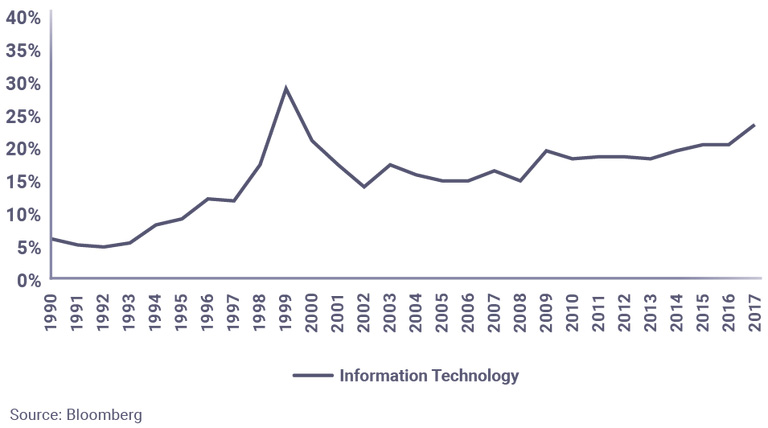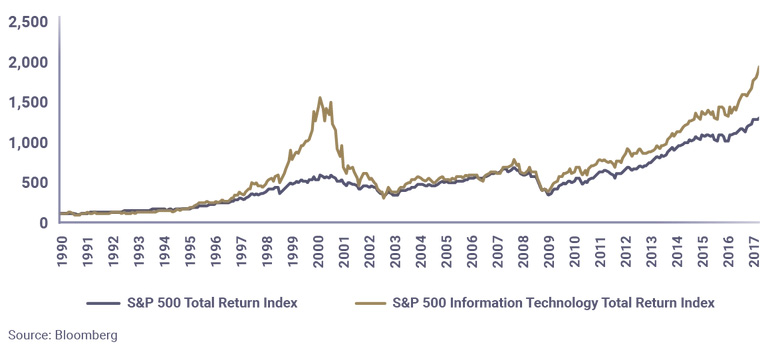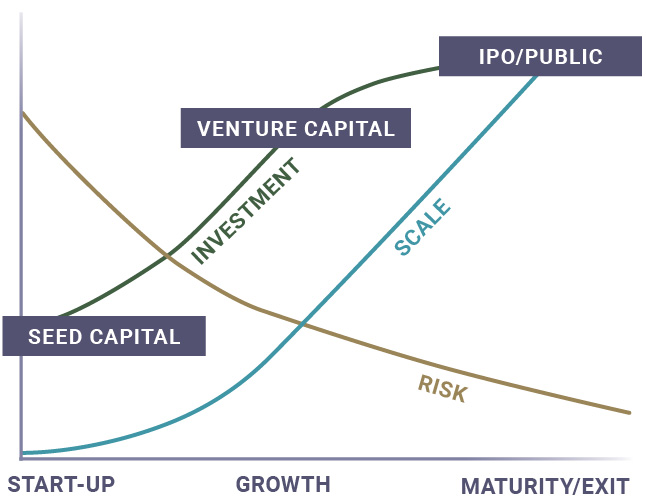Technology companies have always had a place in GIC’s portfolio. In recent years, as technology has disrupted traditional industries and spawned new businesses, our investing and organizational efforts in this area have also expanded. We answer questions here on how we approach and invest in technology.
What is a technology company?
By a technology company, we mean a company in the ‘information technology’ (IT) sector. It used to be that IT was typically viewed as comprising software and services, technology hardware and equipment, and semiconductor and semiconductor equipment. However, with technology permeating and drastically changing all kinds of businesses, it is increasingly difficult to delineate a pure technology company. In this article, we use ‘technology’ to refer more loosely to companies which sell mostly information technology products and services or are intensive users of technology in economic footprint, in their business models. Examples of the former are mobile phone producers and cyber security service companies, and for the latter, e-commerce companies and social media companies.
Technology has been an important sector for investors over the last 30 years. The two charts below show respectively the share of IT in the S&P 500 Index (a widely-followed composition of representative US stocks) and its return performance since 1990.

Figure 1: Share of IT Sector in S&P 500 (By Market Capitalisation)

Figure 2: Performance of Information Technology Sector (Total Return Index)
How did GIC start investing in the technology space?
GIC has been in this space since our founding. We started by investing in technology companies opened our San Francisco office in 1986, we expanded into venture capital funds. Hence, we went into private venture capital earlier than most other institutional investors. This has given GIC time to build up strong partnerships with leading technology investment managers that have long track records.
How does GIC invest in technology?
GIC’s investments in technology cover all stages of the financing life-cycle of a company: seed (start-up), venture capital (growth), IPO/public equity (maturity and exit), as illustrated in Figure 3.

Figure 3: Financing Life-Cycle of a Company
GIC invests directly and through external fund managers in start-ups, growth companies, pre- and post-listed companies. We also provide seed capital via venture capital funds.
We are organised to cover both strategic positioning and ground level investing. Our Technology Business Group comprises specialists from different asset classes and regions. It monitors and assesses industry trends, and recommends GIC’s overall technology portfolio size and composition, as well as partnership strategy. Early stage investments are mostly handled by our Technology Investment Group through venture capital funds, co-investments and direct investments. We also have sector specialists for public and private market investments.
GIC has a broad investment mandate with flexibility in terms of the development stage, capital structure, investment size, sub-sector, geography and duration. We typically stay invested for the long term, including post-IPO for newer companies. This connects GIC to the whole life-cycle of the company, during which founders can tap GIC for capital at different stages of growth.
It is a crowded space. How does GIC position itself?
Even with the secular trend of technological disruption, we believe there are cycles. So it is most important to stay disciplined through time. Generally, valuations of technology companies have gone up substantially. It pays to be cautious and selective.
GIC looks to being a lifetime partner to our investee companies. Our long-term orientation and flexibility in deploying capital across the private, semi-private and public spaces enable us to grow together with them. We also seek multiple touch points with these companies. For example, with one technology company we invested in its private equity, subsequently invested in its technology venture investment arm, and also participated as a sponsor in its incubator programme.
Besides investee companies, we work collaboratively with our external fund managers. Beyond generating investment returns on our capital, our external fund managers help us to stay abreast of market developments, give us co-investing opportunities and add to the network that our investee companies can tap on.
Our global set-up helps us to spot leads and lags across regions. Having a local presence in innovation hubs such as Silicon Valley and Beijing enables us to capture interesting opportunities. This is in turn backed by our global presence through eight other offices and experience in multiple asset classes. We leverage our global networks to share useful connections and insights with our investee companies. For example, our recent GIC Insights Forum and the Bridge Forum generated new business ideas and our partners struck new relationships at the events.
With the wide range of technology investments, how do you decide?
GIC has no fixed allocation to any specific geographies and sub-sectors. We study industry trends to help filter areas for deeper research and potential opportunities, not to allocate capital.
We invest through a bottom-up stock selection process, using the same long-term, fundamentals-based approach as the other asset classes. For early-stage companies, due diligence on the calibre and integrity of the entrepreneur is indispensable. So is a clear understanding of the business model. One way we do this is by spending time with the production engineers. After seeing what problems they can or cannot solve in one domain, we can gauge the success of other domains. Another way is by getting first-hand experience as a customer, which provides us with a direct assessment of products or services. However, investments carry risks, especially investments in young companies. In technology investments, we manage the risks by diversifying across sectors and life-cycle stages, having a robust investment process, adhering to strict pricing discipline, understanding the risk-reward calculus and sizing the investment.
What key trends are you watching?
First, as technology is reshaping entire industries, we need to look beyond traditional investment categories. Incumbents are constantly challenged by disruptors from outside the traditional verticals. For instance, an e-commerce company can now offer wealth management and enterprise infrastructure services, while the sharing economy is changing the competition landscape for hotels, transportation and luxury retail.
Second, disruption is not a zero-sum game. By targeting inefficiencies and creating scalable platforms, disruptors are enabling better consumer choices and experiences, compelling incumbents to do the same, and creating new industries. Start-ups also provide innovation capacity that large companies need. Companies are setting up corporate venture funds and incubators, so as to discover, work with and invest in promising start-ups. By providing start-ups with better resources, networks and business platforms, they also improve the chances of their success. We see this in the pharmaceutical industry, where large companies are licensing drugs developed by smaller start-ups.
Third, technology has enabled business ‘ecosystems’ to form a powerful strategy in this highly competitive environment. Large technology companies have created rich digital platforms where different component businesses reinforce each other. Customers are ‘locked in’ via multiple channels such as e-commerce, search, social media and entertainment. In addition, data-rich platforms provide hyper-customised experiences, allowing the companies to cross-sell effectively, take more wallet share and build customer loyalty. For investors, an expanded customer base often creates a network effect, providing an ‘investor surplus’ as additional profits are generated without additional capital from investors.
Fourth, emerging markets, notably China and India, are seeing their own wave of innovation, and in some cases a faster adoption curve than in developed markets. Leapfrogging is happening due to their greater openness to experiment, less mature industries, fewer legacy arrangements, underserved customer base, and strong talent pool. This is a very important trend to participate in.
With technology reshaping entire industries and categories, how is GIC responding?
Our ‘ODE to technology framework’ describes our holistic approach to responding to the repercussions of disruptive technology. O-D-E stands for Offence, Defence and Enterprise Excellence. It covers both our investing and organizational responses to this important force of change and uncertainty.
Offence: This is about how we gain from technological disruption by investing in the winners of this shift. While this naturally puts the spotlight on new companies, the large incumbents, with their vast resources, are not to be overlooked. Nevertheless, new technology will mean the rise of many promising entrants. New business models are being rolled out regularly, requiring us to be open to changing assumptions about industry classification, the pace of change, brand value, consumer loyalty, product bundling, industry structure, regulatory regime and the like.
Defence: This is how we protect our existing investments as they face disruption. Given our diversified portfolio that holds many established companies, this defensive stance is as important as offence, if not more so. In fact, a huge benefit from our investing in technology is a better appreciation of the threats and opportunities faced by companies in our portfolio. In some cases, we have worked with existing investees to adjust to the new reality. This helps us to protect our portfolio value.
Enterprise Excellence: The investment business is not immune from this trend, with the same offence and defence forces evident in our business. New technology, especially in data analytics and machine learning, is increasingly being applied in investment management. Investment approaches are also becoming increasingly technology intensive. GIC needs to change.
We have invested significantly in such capabilities, adjusted our investment processes, and we will need to do more. Importantly, we recognise the need for structure and culture change, including the use of agile methods in our work processes, greater experimentation and embedding technology specialists in our investment teams.
Facing the highly uncertain and rapid nature of technological disruption, GIC, like all businesses, is on an uncharted path, and will surely learn many lessons along the way.
We believe our approach to finding good companies, good technologies and good business models, and applying these to our investment and organizational strategies, will give us a competitive edge, and leave us well-placed to invest in this challenging environment.







